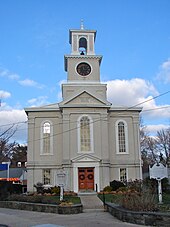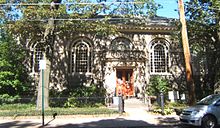|
Chestnut Hill, Philadelphia
Chestnut Hill is a neighborhood in the Northwest Philadelphia section of Philadelphia, Pennsylvania, United States. It is known for the high incomes of its residents and high real estate values, as well as its private schools. GeographyBoundariesChestnut Hill is bounded as follows:
ZIP codeThe USPS does not officially correlate neighborhood names to Philadelphia ZIP codes (all are called simply "Philadelphia" or "Phila").[1] However, the 19118 ZIP code is almost entirely coterminous with the cultural-consensus boundaries of Chestnut Hill. History  The village of Chestnut Hill was part of the German Township laid out by Francis Daniel Pastorius and came to include the settlements originally known as Sommerhausen and Crefeld, as well as part of Cresheim. It served as a gateway between Philadelphia and the nearby farmlands. During the American Revolutionary War era (late 18th century), the area was one of many summer vacation spots due to its higher elevation, 400–500 feet (120 to 150 m) above sea level, and cooler temperatures than the historic Center City. Chestnut Hill is still stereotypically known as one of the more affluent sections of Philadelphia. However, there are many residents who fall within lower/middle class incomes. Chestnut Hill (along with many other towns and farmlands of Philadelphia County) became part of the City of Philadelphia in 1854 as part of the Act of Consolidation, when the County and the City became completely coterminous. In the same year, the Chestnut Hill Railroad (Chestnut Hill East Line) opened, making an easy commute to and from Center City. In 1884, a second railway line was added by the Philadelphia, Germantown and Chestnut Hill Railroad (Connecting Railway). During the American Civil War, Chestnut Hill was home to Mower U.S. Army General Hospital, constructed to serve Union army soldiers. From the mid-19th century through the mid-20th, the neighborhood served as both a "railroad suburb" and a "streetcar suburb" of Center City; although it was part of Philadelphia, it was a leafy outlying part functioning as a bedroom community. The neighborhood contains a wide variety of 19th and early 20th century residential buildings by many of the most prominent Philadelphia architects. In 1985, the neighborhood was designated as the Chestnut Hill Historic District with the National Register of Historic Places.[2] Citing its natural resources, architectural character, and thoughtful planning, the American Planning Association has recognized it among its Great Places in America.[3] Historic and notable architecture  The Chestnut Hill listings on the National Register of Historic Places:
Other historic and notable properties include:
Public transportationPublic transportation in southeastern Pennsylvania, which includes Philadelphia and the surrounding counties, is provided by SEPTA, the region's mass transit authority. Regional rail (commuter rail) Two SEPTA Regional Rail commuter train lines serve Chestnut Hill: the Chestnut Hill East Line and Chestnut Hill West Line. BusesChestnut Hill is served by SEPTA bus routes from both the City Transit Division (23, 77 and L) and the Suburban Division (94 and 97). TrolleysTrams in the southeastern Pennsylvania region are known as trolleys. The trolley network of this region was very extensive prior to World War II, but has shrunk since that era. Chestnut Hill was formerly served by trolleys. Trolley service to Chestnut Hill began in 1894, and trolley tracks still run down the Belgian-block-paved main street of the neighborhood, Germantown Avenue, which was served by SEPTA Route 23. SEPTA "temporarily suspended" regular trolley service in 1992. From 1992 until 1996, weekend-only service ran between Chestnut Hill and Mount Airy, re-branded The "Chestnut Hill Trolley."[4] Sporadic trolley charter trips ran down Germantown Avenue and into North Philadelphia until 2003.[5] In 2010, the Pennsylvania Department of Transportation completed work on restoring segments of the trolley infrastructure and streetscape in Chestnut Hill, Mount Airy and Germantown. As of 2011, SEPTA spokespeople publicly state that there are no plans to reinstate trolley service on Route 23,[6] despite claims to the contrary in their annual capital budget reports.[7] The dismantling of Route 23 infrastructure is unpopular with a large segment of local residents.[6] EducationColleges and universitiesPrimary and secondary schoolsPublic education Residents are zoned to schools in the School District of Philadelphia. Students in grades kindergarten through 8 are zoned to John Story Jenks School,[8] while students in grades 9 through 12 are zoned to Roxborough High School.[9] Students were previously zoned to Germantown High School.[10][11] Private educationChestnut Hill is home to several private schools. The Pre-K-12 Springside Chestnut Hill Academy, educates single-sex Pre-K-8 and coed 9–12, formed in 2010 through the merger of Springside School and Chestnut Hill Academy. Other private schools in Chestnut Hill are The Crefeld School (7-12), and the K-8 Norwood-Fontbonne Academy. [citation needed] Nearby private schools in adjacent neighborhoods that attract some Chestnut Hill residents include Germantown Friends School, William Penn Charter School, and Germantown Academy. Public libraries Free Library of Philadelphia operates the Chestnut Hill Branch at 8711 Germantown Avenue.[12] Parks, arboretums, and recreation
The community previously held the Chestnut Hill Harry Potter Festival, but in 2018 the event was canceled since the copyright owners cracked down on for-profit uses of the brand.[13] In 2017 there were 50,000 attendees to that year's 7th annual event.[14][15] In 2019, the festival resumed as the Witches & Wizards Festival.[16] Other notable civic institutions Notable people
ReferencesWikimedia Commons has media related to Chestnut Hill, Philadelphia.
External links |
||||||||||||||||||||||

